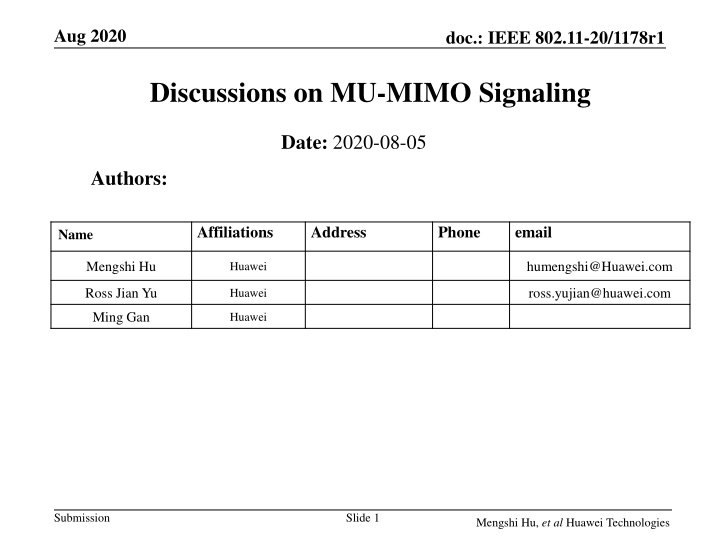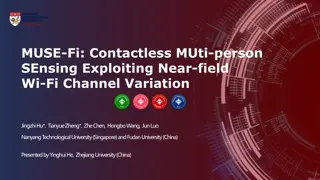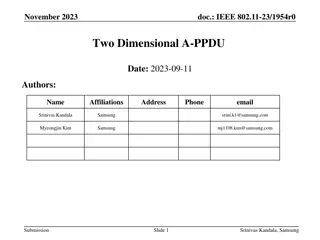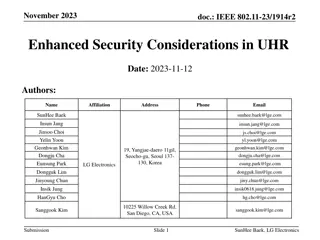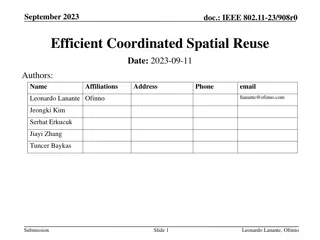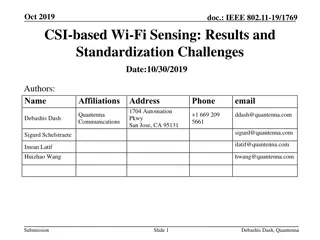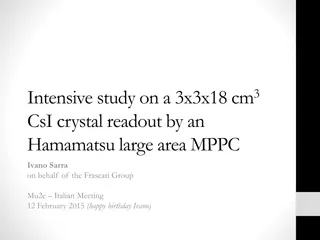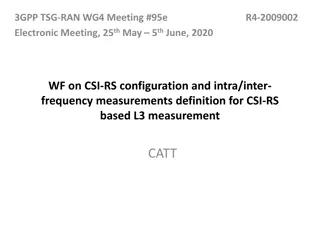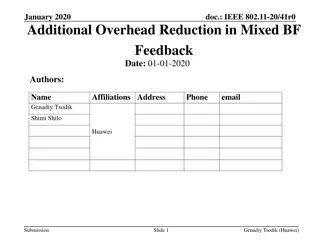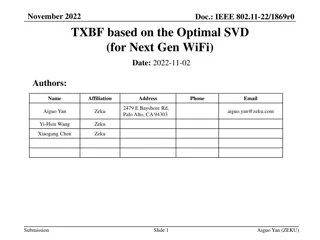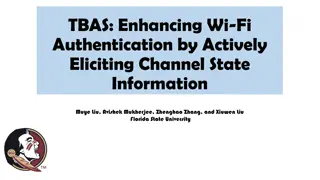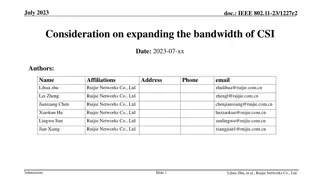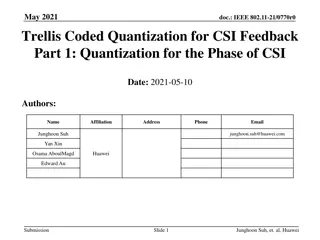Discussions on CSI Feedback Reduction in UHR
In this contribution, the need to reduce overhead of Channel State Information (CSI) feedback for UHR and potential methods of reduction are discussed, considering features like multi-AP joint transmission, beamforming, larger bandwidths, and more. The analysis of CSI overhead and benefits of reduced feedback overhead are elaborated in detail.
Download Presentation

Please find below an Image/Link to download the presentation.
The content on the website is provided AS IS for your information and personal use only. It may not be sold, licensed, or shared on other websites without obtaining consent from the author.If you encounter any issues during the download, it is possible that the publisher has removed the file from their server.
You are allowed to download the files provided on this website for personal or commercial use, subject to the condition that they are used lawfully. All files are the property of their respective owners.
The content on the website is provided AS IS for your information and personal use only. It may not be sold, licensed, or shared on other websites without obtaining consent from the author.
E N D
Presentation Transcript
Aug 2020 doc.: IEEE 802.11-20/1178r1 Discussions on MU-MIMO Signaling Date: 2020-08-05 Authors: Affiliations Address Phone email Name Mengshi Hu humengshi@Huawei.com Huawei Ross Jian Yu ross.yujian@huawei.com Huawei Ming Gan Huawei Submission Slide 1 Mengshi Hu, et al Huawei Technologies
Aug 2020 doc.: IEEE 802.11-20/1178r1 Recap: MU-MIMO Indication in 11ax User field position In 11ax, there exists a Spatial Configuration subfield in each MU-MIMO User field.For a given value of Nuser, the MU-MIMO information can be indicated as follows: The number of spatial streams for the user is derived by using the row corresponding to the signaled 4-bit Spatial Configuration subfield and the column corresponding to the User field position in the User Specific field. The starting stream index for the user is computed by summing the NSTS in the columns prior to the column indicated by the user sUser field position. Spatial Configuration subfield Nuser Therefore, for an MU-MIMO user, the below information is needed to obtain its spatial configuration information Spatial Configuration subfield User field position Nuser (Number of MU-MIMO users) Submission Slide 2 Mengshi Hu, et al Huawei Technologies
Aug 2020 doc.: IEEE 802.11-20/1178r1 MU-MIMO in Per-80MHz Preamble Signaling On the basis of the agreed EHT PPDU format sent to multiple users, an efficient per-80MHz preamble structure is designed [1-3] U-SIG2 EHT-SIG2_2 U-SIG2 EHT-SIG2_1 A STA only needs to process up to one 80 MHz segment of the pre-EHT preamble (up-to and including EHT-SIG) to get all the assignment information for itself. Secondary 80MHz U-SIG2 EHT-SIG2_2 U-SIG2 EHT-SIG2_1 U-SIG1 EHT-SIG1_2 U-SIG1 EHT-SIG1_1 Primary 80MHz U-SIG1 EHT-SIG1_2 U-SIG1 EHT-SIG1_1 In this structure, if we follow the MU-MIMO indication method in 11ax, the signaling overhead will be high when the users participating in an MU-MIMO belong to different segments (for both OFDMA and non-OFDMA cases). MU-MIMO Users MU-MIMO with users belonging to more than one segment Users in Segment 1 User A User B Users in Segment 2 User C User D User E ... ... RU/MRU In the following, we first give the details of the above overhead analysis in OFDMA cases. Submission Slide 3 Mengshi Hu, et al Huawei Technologies
Aug 2020 doc.: IEEE 802.11-20/1178r1 Signal All User Fields (Opt. 1) In 11ax, as we have shown previously, the User field position and the total number of MU-MIMO users are needed for a user to obtain its MU-MIMO information in Spatial Configuration table (See Appendix A [4]). If we follow the 11ax style, signaling all the user fields participating in an MU-MIMO is needed to maintain the User field positions. Here we call this method the Opt. 1 [5]. MU-MIMO Users Yellow block: Corresponds to the users parked on segment 1 Orange block: Corresponds to the users parked on segment 2 White block: Dummy User fields Users in Segment 1 User A User B Users in Segment 2 User C User D User E ... ... 242-tone RU Examples for Opt. 1 A 242-tone RU has 5 MU-MIMO users. The 1st and 3rd users in the Spatial Configuration table belong to Segment 1, and the 2nd, 4th and 5th users belong to Segment 2. Opt 1.1 Opt 1.2 User field 1 User field 2 User fields in Segment 1 User field 3 User field 4 User field 5 ... User field 1 User field 2 User fields in Segment 1 User field 3 User field 4 User field 5 ... ... ... User field 1 User field 2 User fields in Segment 2 User field 3 User field 4 User field 5 ... User field 1 User field 2 User fields in Segment 2 User field 3 User field 4 User field 5 ... ... ... Submission Slide 4 Mengshi Hu, et al Huawei Technologies
Aug 2020 doc.: IEEE 802.11-20/1178r1 Add Special User Field (Opt. 2) Although Opt 1 has less specification modification, the overhead is high because it needs some additional User fields to maintain the User field position. To save the overhead of user fields, in Opt 2 we propose to add a Special User field to inform the total number of MU-MIMO users (Nuser) and the orders (User field positions) in the corresponding segment. The Special User field only occurs when there exists multi-segment MU-MIMO, and can be indicated by a special STA ID. This Special User field is at the front of the corresponding user fields of each multi-segment MU-MIMO. We still use the table of Spatial Configuration table to inform the spatial configuration. User field with special STA ID Subfield Number of bits Description STA ID 11 Special STA ID (indicating a user field signaling the information of multi-segment MU-MIMO) Indicates the total number of MU-MIMO users (Nuser, not the number of users in a segment) in one multi-segment MU-MIMO Number of MU- MIMO Users 3 Used to show the orders of the user fields (User field positions) in the table of spatial configuration subfield encoding Order Bitmap 8 Note: Needed information for MU-MIMO 1. Spatial Configuration subfield 2. User field position 3. Nuser (Number of MU-MIMO users) Submission Slide 5 Mengshi Hu, et al Huawei Technologies
Aug 2020 doc.: IEEE 802.11-20/1178r1 Add Special User Field (Opt. 2) Yellow block: Corresponds to the users parked on segment 1 Orange block: Corresponds to the users parked on segment 2 White block: Special User fields used to inform the spatial configuration. MU-MIMO Users Users in Segment 1 User A User B Users in Segment 2 User C User D User E ... ... 242-tone RU Example for Opt. 2 A 242-tone RU has 5 MU-MIMO users. The 1st and 3rd users in the Spatial Configuration table belong to segment 1, and the 2nd, 4th and 5th users belong to segment 2. This Special User field is at the front of the corresponding user fields of each multi-segment MU-MIMO. This number is indicated by the RU Allocation subfield Spatial Configuration subfield exists in these User fields User field 1 User field 2 Special User field ... ... User fields in Segment 1 Order Bitmap in Special User field: 1010 0000 (indicates the User field positions in Spatial Configuration table) Number of MU-MIMO Users (indicates Nuser) User field 1 User field 2 User field 3 Special User field ... ... User fields in Segment 2 Note: Needed information for MU-MIMO 1. Spatial Configuration subfield 2. User field position 3. Nuser (Number of MU-MIMO users) Submission Slide 6 Mengshi Hu, et al Huawei Technologies
Aug 2020 doc.: IEEE 802.11-20/1178r1 Overhead Analysis for OFDMA Cases Parameter N is the total number of MU-MIMO users for an RU/MRU (N>=2) Ni is the number of MU-MIMO users in segment i for an RU/MRU Options Overhead in a segment Overhead in all segments Opt 1 Signal all User fields For an RU/MRU, the number of User fields in segment i is equal to the total number of MU-MIMO users (N) For one multi-segment MU-MIMO with users in X segments, the total number of User fields in these segments is XN for an RU/MRU. Opt 2 Add a Special User field For an RU/MRU, the number of User fields in segment i is equal to the number of MU-MIMO users in the segment + 1 (Ni+1) For one multi-segment MU-MIMO with users in Xsegments, the total number of User fields in these segments are N+X for an RU/MRU. Analysis The user fields that can be saved in a segment for an RU/MRU is N-Ni-1 With the increase of N and X, the overhead benefit of Opt 2 becomes larger. Furthermore, if there are more than one multi-segment MU-MIMO in OFDMA cases, the overhead can be further saved. In the following, we give some concrete analyses on overhead comparison. Submission Slide 7 Mengshi Hu, et al Huawei Technologies
Aug 2020 doc.: IEEE 802.11-20/1178r1 Examples of Overhead (1/4) Extreme case (no load balance, 242-tone RU) Corresponds to Content Channel 1 Users parking on segment 2 320MHz Users parking on other segments Each blue block has 8 MU-MIMO users 242 242 242 242 242 242 242 242 242 242 242 242 242 242 242 242 Segment 2 Take Content Channel 1 as an example (corresponding to the blue blocks). if in each blue block there exists an MU-MIMO user parking on segment 2, the needed number of user fields in the Content Channel 1 in segment 2 is equal to: 8*8 = 64 User fields for Content Channel 1 for Opt. 1 8+8 = 16 User fields for Content Channel 1 for Opt. 2 Assume that each User field needs 22+5 bits. Then the number of additional needed bits for Opt. 1 is (64-16)*27 = 1296. Around 50 symbols (1296/26 49.8) can be saved for one segment at MCS0. Submission Slide 8 Mengshi Hu, et al Huawei Technologies
Aug 2020 doc.: IEEE 802.11-20/1178r1 Examples of Overhead (2/4) Extreme case (load balance, 484-tone RU) Corresponds to Content Channel 1 Users parking on segment 2 320MHz Users parking on other segments Each blue block has 8 MU-MIMO users 484 484 484 484 484 484 484 484 Segment 2 If in each blue block there exists an MU-MIMO user parked on segment 2, the needed number of user fields in the two Content Channels in segment 2 is equal to: 8*8 = 64 User fields in two content channels for Opt. 1 8+8 = 16 User fields in two content channels for Opt. 2 Assume that each User field needs 22+5 bits. Because 484-tone RU support load balance in two Content Channels, the number of additional needed bits for Opt. 1 is (64-16)*27/2 = 648 Around 25 symbols (648/26 24.9) can be saved at MCS0. Submission Slide 9 Mengshi Hu, et al Huawei Technologies
Aug 2020 doc.: IEEE 802.11-20/1178r1 Examples of Overhead (3/4) Practical case (no load balance, 242-tone RU) Corresponds to Content Channel 1 Users parking on segment 2 320MHz Users parking on other segments Each blue block has 8 MU-MIMO users 242 242 242 242 242 242 242 242 242 242 242 242 242 242 242 242 Segment 2 Take Content Channel 1 as an example (corresponding to the blue block). if in the blue block there exists some MU-MIMO users parking on segment 2, the needed number of user fields in Content Channel 1 in segment 2 for this RU is equal to: 8 User fields for Content Channel 1 for Opt. 1 2~8 User fields for Content Channel 1 for Opt. 2 Assume that each User field needs 22+5 bits. Then the number of additional needed bits for Opt. 1 is (0~6)*27 = 0~162. Around 0~7 symbols can be saved at MCS0 for one RU/MRU. Note: The user fields that can be approximately saved in a segment for an RU/MRU is N-Ni-1 Submission Slide 10 Mengshi Hu, et al Huawei Technologies
Aug 2020 doc.: IEEE 802.11-20/1178r1 Examples of Overhead (4/4) Practical case (load balance, 484-tone RU) Corresponds to Content Channel 1 Users parking on segment 2 320MHz Users parking on other segments Each blue block has 8 MU-MIMO users 484 484 484 484 484 484 484 484 Segment 2 If in the blue block there exists an MU-MIMO user parked on segment 2, the needed number of user fields in the two Content Channels in segment 2 is equal to: 8 User fields in two content channels for Opt. 1 2~8 User fields in two content channels for Opt. 2 Assume that each User field needs 22+5 bits. Because 484-tone RU support load balance in two Content Channels, the number of additional needed bits for Opt. 1 is (0~6)*27/2 = 0~81 Around 0~4 symbols can be saved at MCS0 for one RU/MRU. In the following, we give some considerations on non-OFDMA cases. Note: The user fields that can be approximately saved in a segment for an RU/MRU is N-Ni-1 Submission Slide 11 Mengshi Hu, et al Huawei Technologies
Aug 2020 doc.: IEEE 802.11-20/1178r1 Non-OFDMA Cases based on Opt. 1 Non-OFDMA cases based on Opt 1 EHT has adopted that the number of EHT-SIG symbols field always exists in U-SIG of a PPDU that is not a EHT TB PPDU The field is not reinterpreted as the number of MU-MIMO users In OFDMA transmission, the number of MU-MIMO users can be indicated by RU Allocation subfield In Non-OFDMA transmission, the number of MU-MIMO users can exist in the EHT-SIG to inform the total number of MU-MIMO users. The total number of User fields in two content channels is equal to the total number of MU-MIMO users (N) Example: L-STF L-LTF L-SIG RL-SIG U-SIG EHT-SIG EHT-STF EHT-LTF DATA PE Common field User Specific field Number of MU-MIMO Users ... ... Submission Slide 12 Mengshi Hu, et al Huawei Technologies
Aug 2020 doc.: IEEE 802.11-20/1178r1 Non-OFDMA Cases based on Opt. 2 Non-OFDMA cases based on Opt 2 Using a Special User field can also support multi-segment MU-MIMO in non-OFDMA cases. However, we can also remove the Special User field, and add the Order Bitmap (e.g. an 8-bit bitmap) to EHT-SIG in non-OFDMA cases. The number of MU-MIMO users is also needed in the EHT-SIG to inform the total number of MU-MIMO users. The Order Bitmap can indicate the User field positions and the number of User fields in the corresponding segment. The existence of this subfield can also be indicated by some other subfields. The total number of User fields in two content channels is equal to the number of MU-MIMO users in the segment (Ni) Example: L-STF L-LTF L-SIG RL-SIG U-SIG EHT-SIG EHT-STF EHT-LTF DATA PE Common field User Specific field Number of MU-MIMO Users ... ... ... Order Bitmap e.g. 1011 0000 Submission Slide 13 Mengshi Hu, et al Huawei Technologies
Aug 2020 doc.: IEEE 802.11-20/1178r1 Summary Proposed Opt. 2 to further reduce the overhead in the cases where the users participating in an MU-MIMO belong to different segments Needed number of User fields in a segment for an RU/MRU with multi- segment MU-MIMO: N is the total number of MU-MIMO users for an RU/MRU Ni is the number of MU-MIMO users in segment i for an RU/MRU Opt. 1 Opt. 2 N Ni+1(Add a Special User field) Ni+1(Add a Special User field)or Ni(Use an 8-bit subfield) OFDMA cases N Non-OFDMA cases Submission Slide 14 Mengshi Hu, et al Huawei Technologies
Aug 2020 doc.: IEEE 802.11-20/1178r1 References [1] IEEE 802.11-20/0439r0 Efficient EHT Preamble Design [2] IEEE 802.11-20/0380r0 U-SIG Structure and Preamble Processing [3] IEEE 802.11-20/0605r0 Further Discussions on Efficient EHT Preamble [4] IEEE 802.11-20/0930r3 Consideration on User-specific field in EHT-SIG [5] IEEE 802.11-20/1102r0 Zero User RUs for Per-80MHz Resource Unit Allocation Signaling Submission Slide 15 Mengshi Hu, et al Huawei Technologies
Aug 2020 doc.: IEEE 802.11-20/1178r1 Straw Poll #1 Do you agree that the Number of MU-MIMO Users subfield exists in the Common field of EHT-SIG of an EHT MU PPDU in a non-OFDMA transmission? Note: The Number of MU-MIMO Users subfield indicates the total number of MU-MIMO users in a non-OFDMA transmission. Y/N/A Submission Slide 16 Mengshi Hu, et al Huawei Technologies
Aug 2020 doc.: IEEE 802.11-20/1178r1 Straw Poll #2 Do you agree that for an RU/MRU with MU-MIMO, the corresponding number of MU-MIMO User fields in a segment can be smaller than the total number of MU-MIMO users? Y/N/A Submission Slide 17 Mengshi Hu, et al Huawei Technologies
Aug 2020 doc.: IEEE 802.11-20/1178r1 Straw Poll #3 Do you agree that a Special User field can be used in the cases where the users participating in an MU- MIMO belong to different segments ? The Special User field carries a Number of MU-MIMO Users subfield and an Order Bitmap subfield. Spatial Configuration table parsing is based on the number of MU- MIMO users and the User field positions indicated by the Order Bitmap subfield. Note: RU Allocation subfield in Common field still indicates the number of MU-MIMO User fields (including the Special User field) the RU Allocation subfield contributed in one Content Channel Y/N/A Submission Slide 18 Mengshi Hu, et al Huawei Technologies
Aug 2020 doc.: IEEE 802.11-20/1178r1 Straw Poll #4 Do you agree that an Order Bitmap subfield exists in the Common field of EHT-SIG of an EHT MU PPDU in a non-OFDMA transmission? The Order Bitmap subfield is used to indicate the User field positions and the number of User fields in the corresponding segment. Y/N/A Submission Slide 19 Mengshi Hu, et al Huawei Technologies
Aug 2020 doc.: IEEE 802.11-20/1178r1 Appendix A: Spatial Configuration table (1/3) Nuser B5 B0 Nsts[1] Nsts[2] Nsts[3] Nsts[4] Nsts[5] Nsts[6] Nsts[7] Nsts[8] Total Nsts total entry 000000-000011 1-4 1 2-5 000100-000110 2-4 2 4-6 2 10 000111-001000 3-4 3 6-7 001001 4 4 8 000000-000011 1-4 1 1 3-6 000100-000110 2-4 2 1 5-7 000111-001000 3-4 3 1 7-8 001001 4 4 1 9 001010-001100 2-4 2 2 6-8 3 20 001101-001110 3-4 3 2 8-9 001111 4 4 2 10 010000-010001 3-4 3 3 9-10 010010 4 4 3 11 010011 4 4 4 12 000000-000011 1-4 1 1 1 4-7 000100-000110 2-4 2 1 1 6-8 000111-001000 3-4 3 1 1 8-9 001001 4 4 1 1 10 001010-001100 2-4 2 2 1 7-9 001101-001110 3-4 3 2 1 9-10 001111 4 4 2 1 11 010000-010001 3-4 3 3 1 10-11 010010 4 4 3 1 12 010011 4 4 4 1 13 4 35 010100-010110 2-4 2 2 2 8-10 010111-011000 3-4 3 2 2 10-11 011001 4 4 2 2 12 011010-011011 3-4 3 3 2 11-12 011100 4 4 3 2 13 011101 4 4 4 2 14 011110-011111 3-4 3 3 3 12-13 100000 4 4 3 3 14 100001 4 4 4 3 15 100010 4 4 4 4 16 Submission Slide 20 Mengshi Hu, et al Huawei Technologies
Aug 2020 doc.: IEEE 802.11-20/1178r1 Appendix A: Spatial Configuration table (2/3) Nuser B5 B0 Nsts[1] 1-4 2-4 3-4 4 2-4 3-4 4 3-4 4 4 2-4 3-4 4 3-4 4 4 3-4 4 4 2-4 3-4 4 3-4 4 4 3-4 4 3-4 1-4 2-4 3-4 4 2-4 3-4 4 3-4 4 4 2-4 3-4 4 3-4 4 4 3-4 4 2-4 3-4 4 3-4 4 3-4 3 2-4 3-4 4 3-4 3 Nsts[2] 1 2 3 4 2 3 4 3 4 4 2 3 4 3 4 4 3 4 4 2 3 4 3 4 4 3 4 3 1 2 3 4 2 3 4 3 4 4 2 3 4 3 4 4 3 4 2 3 4 3 4 3 3 2 3 4 3 3 Nsts[3] 1 1 1 1 2 2 2 3 3 4 2 2 2 3 3 4 3 3 4 2 2 2 3 3 4 3 3 3 1 1 1 1 2 2 2 3 3 4 2 2 2 3 3 4 3 3 2 2 2 3 3 3 3 2 2 2 3 3 Nsts[4] 1 1 1 1 1 1 1 1 1 1 2 2 2 2 2 2 3 3 3 2 2 2 2 2 2 3 3 3 1 1 1 1 1 1 1 1 1 1 2 2 2 2 2 2 3 3 2 2 2 2 2 3 3 2 2 2 2 3 Nsts[5] 1 1 1 1 1 1 1 1 1 1 1 1 1 1 1 1 1 1 1 2 2 2 2 2 2 2 2 3 1 1 1 1 1 1 1 1 1 1 1 1 1 1 1 1 1 1 2 2 2 2 2 2 3 2 2 2 2 2 Nsts[6] Nsts[7] Nsts[8] Total Nsts 5-8 7-9 9-10 11 8-10 10-11 12 11-12 13 14 9-11 11-12 13 12-13 14 15 13-14 15 16 10-12 12-13 14 13-14 15 16 14-15 16 15-16 6-9 8-10 10-11 12 9-11 11-12 13 12-13 14 15 10-12 12-13 14 13-14 15 16 14-15 16 11-13 13-14 15 14-15 16 15-16 16 12-14 14-15 16 15-16 16 total entry 000000-000011 000100-000110 000111-001000 001001 001010-001100 001101-001110 001111 010000-010001 010010 010011 010100-010110 010111-011000 011001 011010-011011 011100 011101 011110-011111 100000 100001 100010-100100 100101-100110 100111 101000-101001 101010 101011 101100-101101 101110 101111-110000 000000-000011 000100-000110 000111-001000 001001 001010-001100 001101-001110 001111 010000-010001 010010 010011 010100-010110 010111-011000 011001 011010-011011 011100 011101 011110-011111 100000 100001-100011 100100-100101 100110 100111-101000 101001 101010 - 101011 101100 101101-101111 110000-110001 110010 110011-110100 110101 5 49 1 1 1 1 1 1 1 1 1 1 1 1 1 1 1 1 1 1 1 1 1 1 1 1 1 2 2 2 2 2 6 54 Submission Slide 21 Mengshi Hu, et al Huawei Technologies
Aug 2020 doc.: IEEE 802.11-20/1178r1 Appendix A: Spatial Configuration table (3/3) Nuser B5 B0 +B92 000000-000011 000100-000110 000111-001000 001001 001010-001100 001101-001110 001111 010000-010001 010010 010011 010100-010110 010111-011000 011001 011010-011011 011100 011101-011110 011111-100001 100010-100011 100100 100101-100110 100111 101000-101010 101011-101100 101101 101110-101111 110000 000000-000011 000100-000110 000111-001000 001001 001010-001100 001101-001110 001111 010000-010001 010010 010011-010101 010110-010111 011000 011001-011010 011011 011100-011110 011111-100000 100001 100010-100100 100101 100110-100111 101000 Nsts[1] 1-4 2-4 3-4 4 2-4 3-4 4 3-4 4 4 2-4 3-4 4 3-4 4 3-4 2-4 3-4 4 3-4 3 2-4 3-4 3 2-4 3 1-4 2-4 3-4 4 2-4 3-4 4 3-4 4 2-4 3-4 4 3-4 3 2-4 3-4 3 2-4 3 2-3 2 Nsts[2] 1 2 3 4 2 3 4 3 4 4 2 3 4 3 4 3 2 3 4 3 3 2 3 3 2 3 1 2 3 4 2 3 4 3 4 2 3 4 3 3 2 3 3 2 3 2 2 Nsts[3] 1 1 1 1 2 2 2 3 3 4 2 2 2 3 3 3 2 2 2 3 3 2 2 3 2 2 1 1 1 1 2 2 2 3 3 2 2 2 3 3 2 2 3 2 2 2 2 Nsts[4] 1 1 1 1 1 1 1 1 1 1 2 2 2 2 2 3 2 2 2 2 3 2 2 2 2 2 1 1 1 1 1 1 1 1 1 2 2 2 2 3 2 2 2 2 2 2 2 Nsts[5] 1 1 1 1 1 1 1 1 1 1 1 1 1 1 1 1 2 2 2 2 2 2 2 2 2 2 1 1 1 1 1 1 1 1 1 1 1 1 1 1 2 2 2 2 2 2 2 Nsts[6] 1 1 1 1 1 1 1 1 1 1 1 1 1 1 1 1 1 1 1 1 1 2 2 2 2 2 1 1 1 1 1 1 1 1 1 1 1 1 1 1 1 1 1 2 2 2 2 Nsts[7] 1 1 1 1 1 1 1 1 1 1 1 1 1 1 1 1 1 1 1 1 1 1 1 1 2 2 1 1 1 1 1 1 1 1 1 1 1 1 1 1 1 1 1 1 1 2 2 Nsts[8] Total Nsts 7-10 9-11 11-12 13 10-12 12-13 14 13-14 15 16 11-13 13-14 15 14-15 16 15-16 12-14 14-15 16 15-16 16 13-15 15-16 16 14-16 16 8-12 10-12 12-13 14 11-13 13-14 15 13-14 16 12-14 14-15 16 15-16 16 13-15 15-16 16 14-16 16 15-16 16 total entry 7 50 1 1 1 1 1 1 1 1 1 1 1 1 1 1 1 1 1 1 1 1 2 8 41 Submission Slide 22 Mengshi Hu, et al Huawei Technologies
